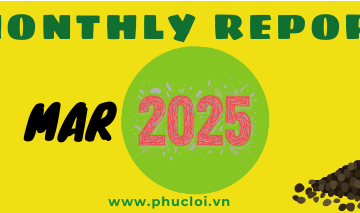Gia Lai pepper farmers developing Sri Lanka plant
HÀ NỘI — Pepper growers in Gia Lai Province are developing pepper plants from Sri Lanka, instead of local varieties, however some agricultural experts are wary of its development potential.
Despite the low market price of pepper early this week, farmers in the Tây Nguyên (Central Highlands) province of Gia Lai were still taking risks on the strange variety from Sri Lanka, with buying prices of VNĐ105,000-115,000 per kg, three times higher than Vĩnh Linh pepper (named after a popular pepper seed originating in Vĩnh Linh District). Vĩnh Linh pepper has been thriving in Gia Lai.
Faced with falling pepper prices and worsening weather in recent years, many pepper growers in Gia Lai Province have fallen into serious debt. Some were forced to destroy their pepper plants to grow other fruit trees and make a living.
Some local households, on the other hand, believed in the future of pepper, and decided to grow Sri Lankan pepper plants, instead of the local type.
According to Nguyễn Trần Quyện, deputy head of Gia Lai Province’s Centre for Pepper Research and Development, the pepper originated in Sri Lanka, and was planted in Thailand, Cambodia and Laos. “It can tolerate drought and has yields three times higher than local plants. In addition, Sri Lankan pepper is also very resistant to pests,” he told Việt Nam News. “My initial research shows it is much like India’s Panniyur pepper.”
The Sri Lanka pepper was first grown in Gia Lai three years ago, by a local man who brought pepper seeds from Cambodia.
“It was confirmed by a Sri Lankan agricultural expert at a recent seminar, when I brought some pepper samples to him, that this variety is similar to that commonly grown in Sri Lanka,” Quyện said.
Nguyễn Văn Long, 60, living in Diên Phú Commune, Pleiku City, one of the households that has turned to Sri Lanka pepper in the area, said some villagers working in Cambodia found this pepper highly productive and resistant to pests and diseases so they brought it back to grow in their native land.
“At first, I tried to plant 100 Sri Lanka pepper plants, then I realised that it grew fast and had good resistance to disease, so this quickly developed to 1,000 new plants,” said Long.
According to Long, the Sri Lankan pepper was similar in price to the Vĩnh Linh pepper of Việt Nam. It was also as easy to grow and pick.
However, the Sri Lanka pepper grows quickly, with the appearance of large leaves and long pods (from 18 to 20cm), so plants need to be fertilised a lot to ensure good growth.
The special feature of Sri Lanka pepper was its productivity. If the best-growing Vietnamese pepper could yield 5-7kg of grain per tree, Sri Lankan pepper offers 17-18 kg of grain per tree.
Currently, Diên Phú Commune has a dozen households that are growing this Sri Lanka pepper, at an average of 100 to 200 trees each.
At present, Long’s pepper garden is growing well. “I initially tested the plants and didn’t take much care of them, but they developed naturally.”
“When the peppers grow well, the large leaves and sprouts are twice as big as sprouts of local pepper. So, I decided to develop 1,000 new pepper plants that are expected to be highly effective.”
Nguyễn Đức Trọng, chairman of Chư Sê Pepper Co-operative, was very considerate about the decision taken by local pepper growers, saying farmers have been advised not to expand production as the Sri Lanka pepper was rather new and its quality and production haven’t been confirmed by competent agencies.
Quyện said the centre has experimented with this pepper tree. The centre also took samples to analyse and evaluate the content of Piperine (the alkaloid responsible for the pungency of black pepper).
Quyện’s centre, in co-ordination with a local pepper export-import company, has studied Sri Lanka pepper samples, discovering that the piperine content of this pepper was just 3.5 per cent, against the standard content for export at 4 per cent.
“We are afraid that if we multiply the Sri Lanka pepper plants widely, it may cause farmers to become disillusioned with pepper again. We will get some samples of this pepper for further analysis and evaluation, while now we are recommending that farmers do not plant it widely,” said Quyện.
“We are waiting for the first harvest next February. And we plan to hybridise this pepper with Vĩnh Linh pepper.”
In Gia Lai, there are about 10ha of Sri Lanka pepper by far. — VNS










